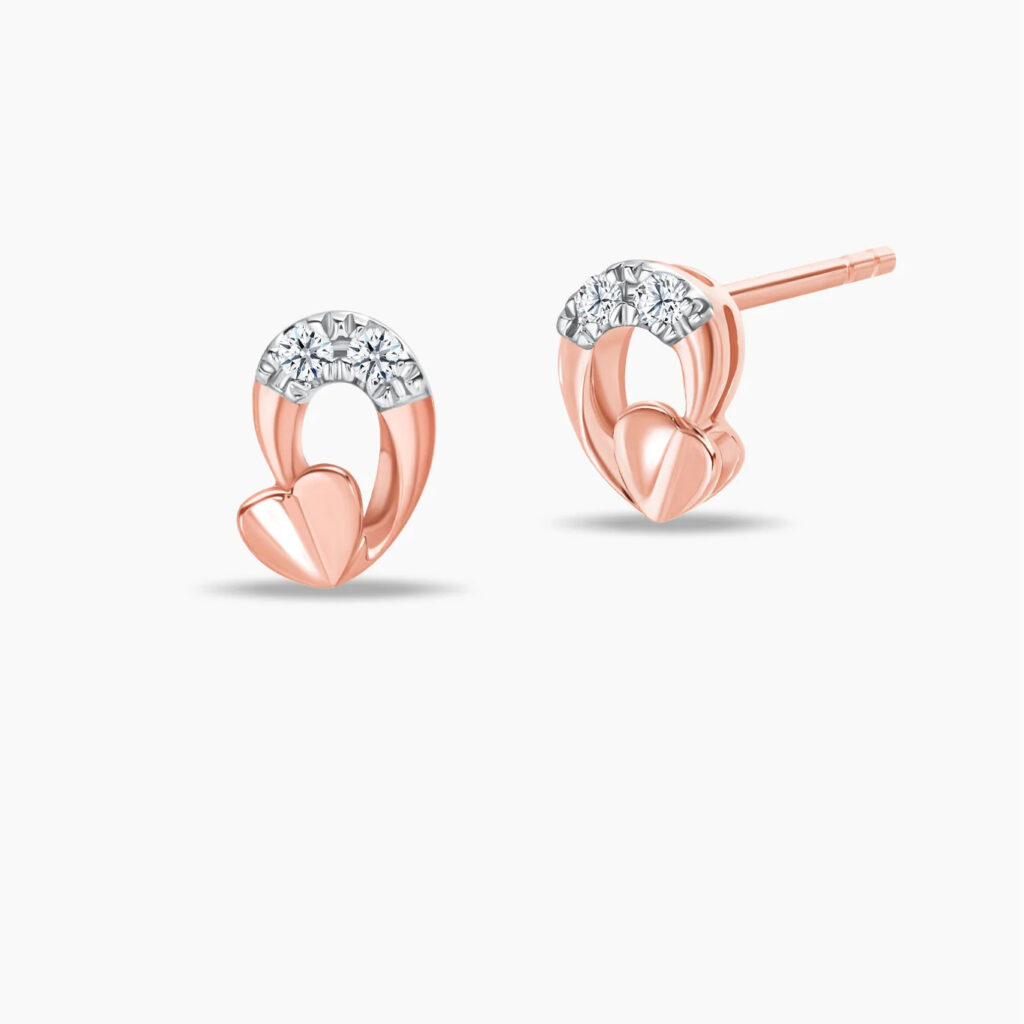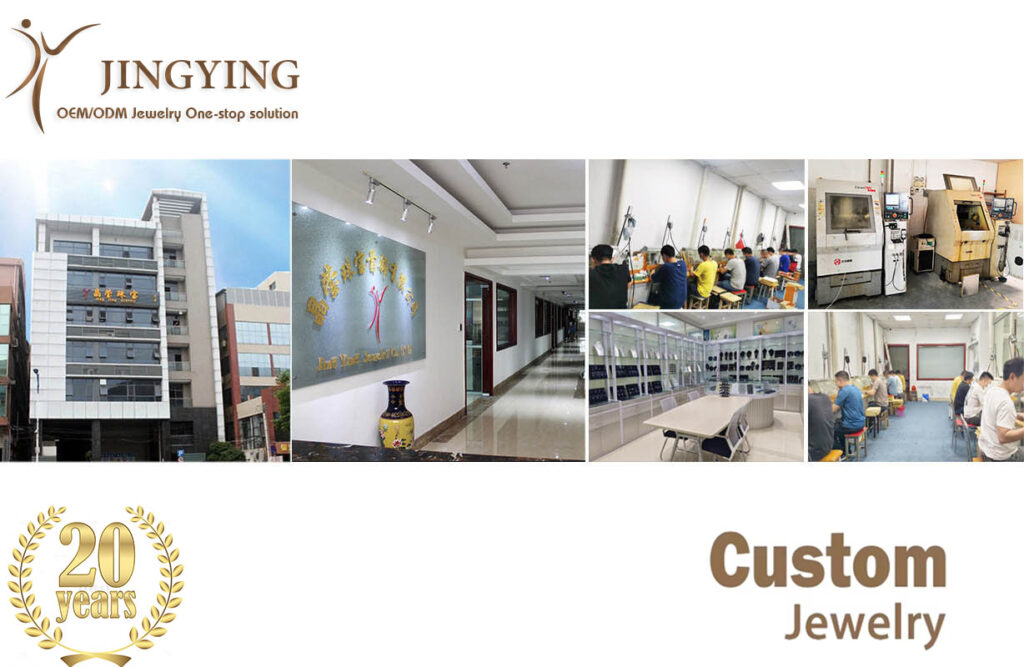Die skepping van 'n juweliersware is 'n boeiende alchemie, 'n reis wat rou transformeer, Ongewerkte materiale in 'n voorwerp van skoonheid, sentiment, en persoonlike uitdrukking. As daardie stuk 'n paar roosgoud-hartvormige oorbelle is, Die proses dra 'n ekstra laag betekenis, vermeng die universele simbool van liefde met die warm, kontemporêre elegansie van een van die mees geliefde juweliersware metale. Die reis van 'n konsep na 'n voltooide produk wat iemand se ore versier, is 'n fassinerende verhaal van kunssinnigheid, presisie ingenieurswese, en noukeurige vakmanskap.

Hierdie proses kan op twee baie verskillende skale onderneem word: die intieme, praktiese benadering van 'n ambagsjuwelier by hul bank, en die vaartbelynde, tegnologies gevorderde werking van 'n grootskaalse vervaardiger soos Jingying, 'n leier in die vervaardiging van pasgemaakte juweliersware. Hierdie artikel sal 'n volledige verskaf, agter-die-skerms verkenning van beide paaie, met besonderhede oor elke stap wat betrokke is om 'n paar roosgoue hartvormige oorbelle tot lewe te bring.

Verdeel 1: Die fondament – Verstaan Rose Gold
Voordat die eerste skets geteken word of die eerste metaal gesmelt word, dit is van kardinale belang om die materiaal self te verstaan. “Roosgoud” is nie 'n suiwer elementêre metaal nie, maar 'n pragtige en duursame legering.
-
Die samestelling: Suiwer goud, bekend as 24-karaat goud, is te sag vir praktiese juweliersware gebruik. Om dit krag en kleur te gee, dit is met ander metale gelegeer. Die kenmerkende pienk-rooi tint van roosgoud kom van 'n hoë koperinhoud. 'n Tipiese legering vir 14K roosgoud is 58.5% suiwer goud, met die oorblywende 41.5% hoofsaaklik koper en 'n klein hoeveelheid silwer om die rooi kleur te temper en werkbaarheid te verbeter. 18K roosgoud (75% suiwer goud) 'n ryker sal hê, minder pienk kleur as gevolg van die hoër goudinhoud.
-
Die “Gevul” vs. “Geplateer” Onderskeiding: Vir oorbelle, wat onderhewig is aan sweet en slytasie, die metode om roosgoud aan te wend is krities vir lang lewe.
-
Roos vergulde: 'n Baie dun laag (dikwels minder as 0.5 mikron) roosgoud word op 'n onedelmetaal geëlektroplateer (gewoonlik koper). Hierdie laag is goedkoop, maar kan vinnig afslyt, die basismetaal daaronder bloot te stel.
-
Roosgoud gevul: Dit is 'n baie beter metode. ’n Dik laag roosgoud (ten minste uitmaak 5% van die item se totale gewig) is meganies gebind aan 'n kern van juweliers’ koper onder geweldige hitte en druk. Dit skep 'n duursame, langdurige produk wat hoogs vlekbestand en hipoallergeen is, bied die voorkoms en gevoel van soliede goud teen 'n meer toeganklike pryspunt. Dit is die standaard vir kwaliteit mode en semi-fyn juweliersware.
-
Soliede Roosgoud: Die hele stuk is gemaak van die roosgoud allooi. Dit is die duurste en luukse opsie.
-
Die proses wat hieronder beskryf word, sal fokus op die skepping van beide soliede en goudgevulde hartvormige oorbelle, aangesien die fundamentele vorming en samestelling prosesse soortgelyk is, verskil hoofsaaklik in die aanvanklike metaalkeuse en die bindingsproses vir gevulde materiaal.
Verdeel 2: Die twee skeppingsweë
Die reis van 'n hartvormige oorbel kan een van twee primêre roetes volg: handvervaardiging en gietstuk. Die keuse hang af van die gewenste uitkoms, volume, en kompleksiteit.
-
Metode a: Handvervaardiging (Die ambagsman se benadering) Dit is die proses om 'n eenmalige of beperkte uitgawe stuk direk van plaatmetaal en draad te skep met handgereedskap. Dit is ideaal vir unieke ontwerpe, prototipes, of 'n diep persoonlike kreatiewe ervaring.
-
Metode B: Gietstuk (Die vervaardiging & Klein Batch-benadering) Dit behels die skep van 'n model en dan gebruik dit om 'n vorm te vorm. Gesmelte metaal word dan in hierdie vorm gegooi om die oorringkomponente te skep. Dit is die metode wat deur vervaardigers gebruik word Jingying Om konsekwent te produseer, stukke van hoë gehalte in enige hoeveelheid, van 'n dosyn tot tienduisende. Dit is ook die enigste haalbare metode om soliede goue oorbelle met komplekse besonderhede te skep.
Ons sal albei paaie in detail verken.
Pad a: Die kuns van handvervaardiging
Hierdie pad is 'n meditasie in presisie, by die juweliersbank uitgevoer.
Stap 1: Ontwerp en konseptualisering
Die proses begin met 'n idee. Die ontwerper besluit oor die styl: Sal dit 'n klassieke wees, simmetriese hart? 'N moderne, meetkundige interpretasie? 'n Paar ineenlopende harte? Het dit 'n uitgesnyde ontwerp of 'n tekstuuroppervlak? Sketse word gemaak, en afmetings word gefinaliseer, gewig en gemak vir die oor oorweeg.
Stap 2: Materiaalkeuse en voorbereiding
Die juwelier kies 'n vel roosgoud (soliede of die basis koper vir later vulsel) van 'n gepaste dikte (gewoonlik 18-20 maatstaf vir oorbelle). Die vel is uitgegloei (verhit met 'n fakkel om dit sag te maak) om dit makliker te maak om mee te werk.
Stap 3: Die oordrag van die ontwerp
Die hartontwerp word op papier gedruk of geteken en op die metaalplaat vasgeplak. Met behulp van 'n skrywer, die juwelier trek die buitelyn stewig na, krap die ontwerp op die metaaloppervlak hieronder.
Stap 4: Saag die vorm
-
Gereedskap: Juwelier se saagraam en ultra-fyn saagblaaie (Bv., 2/0 of 3/0).
-
Prosesseer: Die metaalplaat is aan 'n bankpen vasgemaak. Die saaglem word in die raam ingeryg met tande wat na onder wys. Die juwelier volg noukeurig die geskrewe lyn, met behulp van 'n bestendige, op-en-af beweging om die hartvorm uit te saag. Vir deurboorde ontwerpe (harte met gate in die middel), 'n klein loodsgat word eers geboor om die saaglem deur te ryg.
Stap 5: Lêer en verfyning
Die rofgesaagde rande word glad gemaak en verfyn met 'n stel naaldlêers (woonstel, halfronde, ronde). Hierdie stap definieer die finale kontoer van die hart en verwyder alle saagmerke.
Stap 6: Skuur en vooraf-polisering
Gebruik skuurpapier of skuurblokkies in progressief fyner korrels (van 220 na 1200 gruis), die juwelier skuur die hart, verwyder alle lêermerke en skep 'n gladde, eenvormige oppervlak gereed vir finale polering.
Stap 7: Die skep van die oorringkomponente
’n Hartvormige oorring is selde net ’n hart. Dit vereis ander dele:
-
Poste en Backs: Vir oorbelle, 'n paal moet aan die agterkant van die hart gesoldeer word. Die juwelier vyl 'n plat kol op die hart, berei 'n voorafgemaakte paal en koppelaar voor, en gebruik 'n fakkel en harde soldeersel om dit veilig te heg.
-
Hakies: Vir hangende oorbelle, 'n springring of 'n gesoldeerde lus moet aan die bokant van die hart geskep word. Die juwelier kan ook 'n Franse haak of herdershaak vind van roosgouddraad met die hand smee.
Stap 8: Die goudvulproses (Indien van toepassing)
As die juwelier met koper werk, die gevormde harte word nou na 'n gespesialiseerde fasiliteit gestuur vir die goudvulproses. Die komponente word in 'n walswerk geplaas met 'n vel soliede roosgoud-legering bo-op. Onder uiterste hitte en druk, die twee metale is permanent saamgebind in 'n enkele plaat, wat dan na die finale verlangde dikte getrek word. Die vooraf gevormde harte word dan uit hierdie nuwe goudgevulde vel gesny.
Stap 9: Finale poleer
Gebruik 'n roterende gereedskap met moeselienpoetswiele en poleermiddels (Tripoli vir sny, Rouge vir 'n hoë glans), die juwelier poets die hart tot 'n briljante, spieëlafwerking.
Stap 10: Voeg 'n patina en finale samestelling by (Opsioneel)
Om besonderhede te beklemtoon, 'n oksideermiddel soos 'n swawellewer kan aangewend word om die stuk donkerder te maak. Die hoogtepunte word dan teruggepoets, laat die uitsparings donker vir kontras. Ten einde laaste, alle komponente is saamgestel (Bv., heg die haak aan die hart deur middel van 'n springring).
Pad b: Die akkuraatheid van rolverdeling (Die jingying -metode)
Vir die vervaardiging van veelvuldige identiese pare of ontwerpe met ingewikkelde 3D-besonderhede, gietwerk is die industriestandaard. Dit is die proses wat deur hoëvolume vervaardigers vervolmaak is.
Stap 1: Digitale ontwerp en CAD -modellering
In plaas van 'n handskets, 'N Ontwerper gebruik rekenaargesteunde ontwerp (CAD) sagteware om 'n presiese 3D-model van die hartvormige oorbel te skep. Dit maak voorsiening vir perfekte simmetrie, ingewikkelde oppervlakpatrone, en optimalisering vir gietwerk. Teen Jingying, CAD-ontwerpers werk nou saam met kliënte om konsepte in vervaardigbare digitale lêers te omskep.
Stap 2: 3D Drukwerk (Vinnige prototipering)
Die digitale CAD-lêer word na 'n 3D-drukker met 'n hoë resolusie gestuur. Die drukker bou die model laag vir laag uit 'n spesiale gietwas of hars. Dit skep 'n perfekte fisiese prototipe van die hartoorring, dikwels met die sprue ('n kanaal vir gesmelte metaal) reeds aangeheg.
Stap 3: Skimmel
Die wasmodel word na 'n sentrale was gespuit “boom” met dosyne ander identiese modelle om produksiedoeltreffendheid te maksimeer. Hierdie boom word in 'n staalfles geplaas, en 'n vloeibare beleggings pleister word daar rondom gegiet. Die gips sit in 'n harde, hittebestande vorm.
Stap 4: Uitbranding en rolverdeling
-
Uitbranding: Die kolf word in 'n oond geplaas, en die was binne is gesmelt en “verlore,” laat 'n perfekte hol holte in die vorm van die oorbelle.
-
Gietstuk: Die fles word uit die oond verwyder terwyl dit nog warm is en in 'n vakuum of sentrifugale gietmasjien geplaas. Vooraf afgemete roosgoudlegering (of koper vir vulsel) word in 'n smeltkroes gesmelt en dan in die hol holte gedwing, vul elke mikroskopiese detail.
Stap 5: Verslawing, Sny, en Skoonmaak
Sodra dit afgekoel is, Die gipsvorm word in water geblus, breek dit weg van die metaalboom. Die rowwe, oorbelle wat met spruite bedek is, word van die boom gesny. Hulle word dan in 'n magnetiese tuimelaar met staalskoot getuimel om enige oorblywende belegging te verwyder en die oppervlaktes glad te maak.
Stap 6: Die goudvulproses (Indien van toepassing)
As die gietstukke in koper is, hulle ondergaan nou die meganiese goudvulproses. Die komponente word in 'n kamer geplaas waar hulle in 'n vakuum met positiewe ione van roosgoud gebombardeer word, 'n proses genaamd Fisiese dampneerlegging (PVD), of hulle is geëlektroplateer met 'n buitengewone dik laag roosgoud om aan gevulde standaarde te voldoen.
Stap 7: Afwerking en poleer
Dit is 'n multi-fase proses:
-
Tuimel: Onderdele word met fyner media getuimel vir vooraf poleer.
-
Handwerk: Geskoolde werkers vyl enige oorblywende giethekke af en skuur die stukke.
-
Poleer: Die oorbelle word op gemotoriseerde wiele gepoleer met poleerverbindings om die gespesifiseerde afwerking te bereik (hoë poetsmiddel, setyn, mat).
Stap 8: Streng gehaltebeheer (QC)
Dit is 'n kritieke stap by Jingying. Elke enkele oorbel word ondersoek.
-
Dimensionele Akkuraatheid: Gekontroleer teen die CAD-model.
-
Oppervlakkwaliteit: Geïnspekteer vir putte, skrap, of poleermerke.
-
Goudlaag Integriteit: Vir gevulde stukke, die dikte word geverifieer.
-
Funksionaliteit: Poste word nagegaan vir reguitheid, en rug en hake word getoets vir sekuriteit.
Stap 9: Byeenkoms, Verpakking, en Logistiek
Oorringpale is toegerus met hipo-allergene wrywingsrugstukke of koppelaarrugstukke. Dangle oorbelle word saamgestel met veilige springringe. Die voltooide pare word ultrasonies skoongemaak, geplaas in handelsmerkverpakking, en voorberei vir wêreldwye besending.
Konklusie: Die alchemie van liefde en kunsvlyt
Die proses om roosgoud hartvormige oorbelle te maak is 'n merkwaardige samesmelting van antieke kuns en moderne wetenskap. Of dit nou geskep is deur die gefokusde vaardigheid van 'n ambagsman wat elke kurwe met die hand saag en vyl, of deur die tegnologies georkestreerde ballet van 'n moderne fabriek, die resultaat is 'n voorwerp wat meer as net estetiese waarde dra.
Dit dra die bedoeling van sy ontwerp, die akkuraatheid van sy ingenieurswese, en die ywer van sy vakmanskap. 'n Paar roosgoue hartoorbelle is nie bloot 'n bykomstigheid nie; dit is 'n bewys van menslike kreatiwiteit en ons blywende begeerte om tasbare vorm aan ons mees gekoesterde emosies te gee. Van 'n klomp metaal tot 'n simbool van liefde, die reis van hul skepping is 'n storie so mooi soos die finale produk self.
